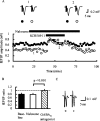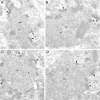Plasticity of GABA(B) receptor-mediated heterosynaptic interactions at mossy fibers after status epilepticus
- PMID: 14673002
- PMCID: PMC6740526
- DOI: 10.1523/JNEUROSCI.23-36-11382.2003
Plasticity of GABA(B) receptor-mediated heterosynaptic interactions at mossy fibers after status epilepticus
Abstract
Several neurotransmitters, including GABA acting at presynaptic GABA(B) receptors, modulate glutamate release at synapses between hippocampal mossy fibers and CA3 pyramidal neurons. This phenomenon gates excitation of the hippocampus and may therefore prevent limbic seizure propagation. Here we report that status epilepticus, triggered by either perforant path stimulation or pilocarpine administration, was followed 24 hr later by a loss of GABA(B) receptor-mediated heterosynaptic depression among populations of mossy fibers. This was accompanied by a decrease in the sensitivity of mossy fiber transmission to the exogenous GABA(B) receptor agonist baclofen. Autoradiography revealed a reduction in GABA(B) receptor binding in the stratum lucidum after status epilepticus. Failure of GABA(B) receptor-mediated modulation of mossy fiber transmission at mossy fibers may contribute to the development of spontaneous seizures after status epilepticus.
Figures







Similar articles
-
Recurrent mossy fiber pathway in rat dentate gyrus: synaptic currents evoked in presence and absence of seizure-induced growth.J Neurophysiol. 1999 Apr;81(4):1645-60. doi: 10.1152/jn.1999.81.4.1645. J Neurophysiol. 1999. PMID: 10200201
-
Short-term frequency-dependent plasticity at recurrent mossy fiber synapses of the epileptic brain.J Neurosci. 2003 Jun 15;23(12):5381-90. doi: 10.1523/JNEUROSCI.23-12-05381.2003. J Neurosci. 2003. PMID: 12832564 Free PMC article.
-
Actions of brain-derived neurotrophic factor in slices from rats with spontaneous seizures and mossy fiber sprouting in the dentate gyrus.J Neurosci. 1999 Jul 1;19(13):5619-31. doi: 10.1523/JNEUROSCI.19-13-05619.1999. J Neurosci. 1999. PMID: 10377368 Free PMC article.
-
Chronic epileptogenic cellular alterations in the limbic system after status epilepticus.Epilepsia. 1999;40 Suppl 1:S23-33; discussion S40-1. doi: 10.1111/j.1528-1157.1999.tb00875.x. Epilepsia. 1999. PMID: 10421558 Review.
-
Role of giant depolarizing potentials in shaping synaptic currents in the developing hippocampus.Crit Rev Neurobiol. 2006;18(1-2):13-23. doi: 10.1615/critrevneurobiol.v18.i1-2.30. Crit Rev Neurobiol. 2006. PMID: 17725505 Review.
Cited by
-
Regulation of neuronal GABA(B) receptor functions by subunit composition.Nat Rev Neurosci. 2012 May 18;13(6):380-94. doi: 10.1038/nrn3249. Nat Rev Neurosci. 2012. PMID: 22595784 Review.
-
Regulating hippocampal hyperexcitability through GABAB Receptors.Physiol Rep. 2014 Apr 22;2(4):e00278. doi: 10.14814/phy2.278. Print 2014. Physiol Rep. 2014. PMID: 24771688 Free PMC article.
-
Dorsal-Ventral Differences in Modulation of Synaptic Transmission in the Hippocampus.Front Synaptic Neurosci. 2020 Jun 18;12:24. doi: 10.3389/fnsyn.2020.00024. eCollection 2020. Front Synaptic Neurosci. 2020. PMID: 32625076 Free PMC article.
-
The Role of Phospholipase C in GABAergic Inhibition and Its Relevance to Epilepsy.Int J Mol Sci. 2021 Mar 19;22(6):3149. doi: 10.3390/ijms22063149. Int J Mol Sci. 2021. PMID: 33808762 Free PMC article. Review.
-
A Brief History and the Significance of the GABAB Receptor.Curr Top Behav Neurosci. 2022;52:1-17. doi: 10.1007/7854_2021_264. Curr Top Behav Neurosci. 2022. PMID: 34595739
References
-
- Andersen KE, Braestrup C, Gronwald FC, Jorgensen AS, Nielsen EB, Sonnewald U, Sorensen PO, Suzdak PD, Knutsen LJ ( 1993) The synthesis of novel GABA uptake inhibitors. 1. Elucidation of the structure-activity studies leading to the choice of (R)-1-[4,4-bis(3-methyl-2-thienyl)-3-butenyl]-3-piperidinecarboxylic acid (tiagabine) as an anticonvulsant drug candidate. J Med Chem 36: 1716-1725. - PubMed
-
- Andre V, Marescaux C, Nehlig A, Fritschy JM ( 2001) Alterations of hippocampal GABAergic system contribute to development of spontaneous recurrent seizures in the rat lithium-pilocarpine model of temporal lobe epilepsy. Hippocampus 11: 452-468. - PubMed
-
- Asztely F, Erdemli G, Kullmann DM ( 1997) Extrasynaptic glutamate spillover in the hippocampus: dependence on temperature and the role of active glutamate uptake. Neuron 8: 281-293. - PubMed
-
- Bekenstein JW, Lothman EW ( 1993) Dormancy of inhibitory interneurons in a model of temporal lobe epilepsy. Science 259: 97-100. - PubMed
-
- Bortolotto ZA, Clarke VR, Delany CM, Parry MC, Smolders I, Vignes M, Ho KH, Miu P, Brinton BT, Fantaske R, Ogden A, Gates M, Ornstein PL, Lodge D, Bleakman D, Collingridge GL ( 1999) Kainate receptors are involved in synaptic plasticity. Nature 402: 297-301. - PubMed
Publication types
MeSH terms
Substances
Grants and funding
LinkOut - more resources
Full Text Sources
Miscellaneous
